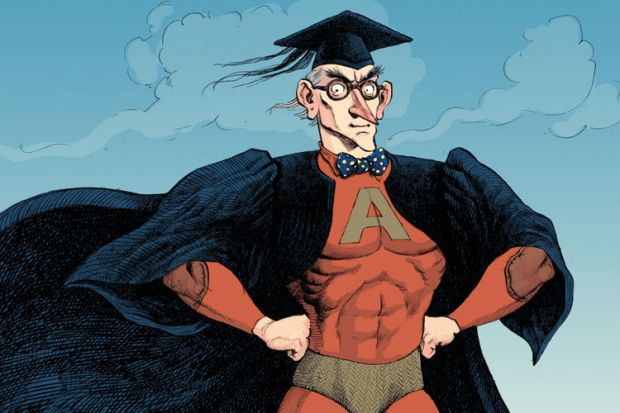Source: David Parkins
The thing about scientist characters is that they can supply the ‘logical’ solution to a plot, either through their fast thinking or via their inventions
Who is the most famous alumnus of Pembroke College in Oxford? Wikipedia suggests the great 18th-century writer and lexicographer Samuel Johnson, who never completed his degree; James Smithson (of Washington DC’s Smithsonian Institution); and William Fulbright (of the Fulbright Scholarships). There is no mention of Charles Francis Xavier, aka Professor X, the paraplegic leader of the X-Men in countless comic books and now a major film franchise.
When universes get rebooted, as is the way in comic books, his backstory changes, but he seems to have graduated early from Harvard, spent two years at Pembroke, got a fistful of PhDs and secured a position as adjunct professor at Columbia University. It is not until he opens a school for gifted young mutants, however, that the fun can really start.
In any event, one episode in the Uncanny X-Men series, originally released in 1984-85, includes a short section set in Oxford. Professor X attends a tutorial by a celebrated geneticist and falls in love with a woman called Moira Kinross, partly because “we were the only ones who had a clue about the ultimate implications of genetic mutation, and we discussed them passionately”. The episode even includes a fairly accurate image of the quadrangle at Pembroke.
Anyone interested in the academic or scientist as superhero can find plenty of other examples within the mainstream world of Marvel Comics. Reed Richards of The Fantastic Four, for example, already has degrees from MIT, Harvard, Columbia and the fictional Empire State University when he embarks on a fateful space flight and a blast of radiation turns him into the infinitely elastic Mister Fantastic.
Alan Moore and David Gibbons are often seen as having reinvented the superhero genre, adding whole new dimensions of human and political depth when they produced Watchmen in 1986. Here, the single character with true superpowers is Jon Ostermann/Dr Manhattan, who has just graduated with a PhD from Princeton when he begins working at the Gila Flats facility for particle physics. It is only when he gets trapped and atomised in the test chamber of the intrinsic field subtractor, and then reconstructs himself by sheer force of will, that he becomes blue-skinned and endowed with powers of telekinesis, teleportation and clairvoyance.
To some academics such tales will seem to have little significance, but not to Stephen Mumford, professor of metaphysics at the University of Nottingham. Mumford suspects that his “choice of career was in part because I grew up reading comics. I was a big fan of Spider-Man, which in its early days was all about university life. He was a student at Empire State University and it seemed like half his professors were super-villains in the making. Dr Curt Connors became The Lizard and Dr Miles Warren became The Jackal. A lot of the fights were on campus…
“I suspect Stan Lee [co-creator of X-Men, The Fantastic Four and Spider-Man, among others] liked to set the stories at universities because it was where a lot of science occurred and science could soon lead to superpowers! But there was also an ethos that learning was good and you should work hard at your studies. I think this was Lee’s personal ethic, though it often had a twist that you needn’t expect rewards for your academic endeavours. It was all reminiscent of the myth of Gyges’ Ring in Plato’s Republic. These people did great things – they sometimes saved the world – but got no praise or acknowledgement. Like Plato’s, Lee’s message was that the good was its own reward.”
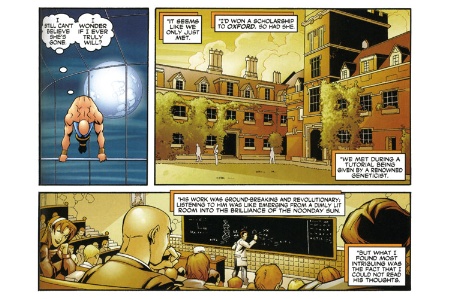
It is perhaps worth taking a step back from all this. Superhero comics are not remotely realistic, so why are the protagonists often given detailed academic CVs? Who could possibly care where you got your degree or did your research once you’ve become invisible or radioactive, a lumbering hulk or the size of an ant, and are using your new powers to save the world?
For comics expert Roger Sabin, reader in popular culture at Central Saint Martins, lists of academic qualifications are “simply a marker of authenticity. Scientists are recurring characters in comics, and usually they’re idiots or evil geniuses. So, if you need your scientist character to be taken seriously, throw in a bit of real science (or, at least, real scientific credentials).”
Just as there is a whole genre of campus novel, there are plenty of scientists, professors, researchers and students scattered across comics and graphic novels. But what forms do they come in and do any of them capture the genuine dramas of research and university life?
We can start with light-hearted adventure comics typified by the Tintin series, whose hero seldom receives much help from the absent-minded Professor Tournesol/Calculus. First appearing in the Tintin magazine from 1946 and drawn in a similar style is Edgar Jacobs’ series featuring Scottish physicist Professor Philip Mortimer and Welsh spymaster Captain Francis Blake. In SOS Meteors, the pair end up in Paris assisting a French colleague, meteorologist Professor Labrousse, as they struggle to work out who is behind a disastrous period of bad weather. A similar dastardly plot involving obelisks, airships, crop circles and underground tunnels is foiled by Professor Munakata, a recurring character in Hoshino Yukinobu’s popular manga comics, who was signed up for a special British Museum Adventure (2011) designed to showcase many of the museum’s treasures.
“The thing about scientist characters,” says Sabin, “is that they can supply the ‘logical’ solution to a plot, either through their fast thinking or via their inventions. At the same time, they’re often funny, so they perform a dual function. Inventions, as we know, can go wrong – amusingly so – and scientists are often portrayed as geeks with no social skills.”
Meanwhile Lucie Lomová’s Les Sauvages (2011), not yet available in English, may look like an old-fashioned adventure story, but it uses the life of Czech botanist and ethnographer Alberto Frič to explore some of the moral complexities of anthropology. When Frič returns to Prague in 1908 with a Paraguayan Indian named Tcherwuish, it soon unleashes some painfully comic culture clashes.
And a number of factual comic books, some with educational aims, incorporate unusual academic characters. In Neurocomic (2013), Matteo Farinella and Hana Roš explain the essentials of brain science by taking their hero on a tour of “neuroland”, through a forest of neurons, across an electric ocean and into a cave of memory. En route, he meets a series of quarrelsome scientists offering conflicting interpretations of what he is seeing.
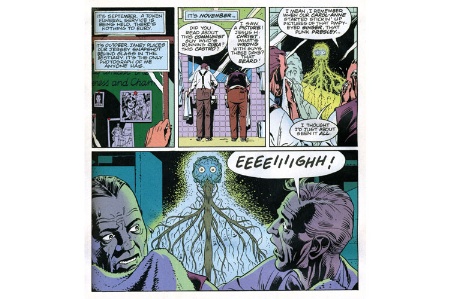
In Neurocomic, Matteo Farinella and Hana Roš explain the essentials of brain science by taking their hero on a tour of ‘neuroland’
Dreams of a Low Carbon Future (2014), recently shortlisted in the National Co-ordinating Centre for Public Engagement’s first Engage Competition, features several fictional professors among its stories of ecologically sustainable societies that once existed or might exist again. Overseen by James McKay, a comics artist who also works as the manager of the University of Leeds’ Doctoral Training Centre for Low Carbon Technologies, it was very much a collaborative project, drawing on the talents of “20 artists and writers; a dozen academics; 40 engineering PhD researchers; 370 schoolchildren aged 10-14; and a host of public engagement facilitators, coordinators and teachers” – all aimed at stimulating discussion about climate change.
Rather closer to home is Tamara Drewe, published as a book in 2007. The cartoonist and illustrator Posy Simmonds has long had a razor-sharp sense of middle-class angst, foibles and hypocrisies, and it is hardly surprising that she has occasionally turned her sights on academics.
The events unfold at a writers’ retreat presided over by a philandering crime novelist and his long-suffering wife. Among the no-hopers dreaming of literary success is American translator Glen Larson, on sabbatical as a visiting professor at the London Medial University. He has just been ejected from a relationship that “grew out of mutual convenience: her apartment was handy for the university and my rent eased the pain of her mortgage”. Not very dynamic at the best of times, he soon discovers “something absolutely corrupting about the goosedown pillows, the fine percale bedsheets, the cozy armchairs, log fires, the voluptuous loungers in shady spots, the really great food and wine. All this makes me uneasy. I mean, should a writer live like a pig in shit and expect the Muse to call?”
Into this quiet world comes the local siren, Tamara Drewe, whose recent nose job and daring pair of shorts give rise to much comment. “Weird, the kind of glances a pretty woman attracts,” reflects Larson. “I mean, any other beautiful, fecund creature – a great-looking sheep or something – you look at admiringly. But I don’t sense any of that. I’m picking up…well, lust, certainly, but also surprise, irritation, disapproval.” Only those working within universities can decide how plausibly Simmonds captures the voice of a second-rate academic.
Cartoonist Daniel Clowes turns a similarly satirical eye on art schools. He is probably most famous for Ghost World, which was turned into a film in 2001, but his 1991 strip “Art School Confidential” gives a cynical insider’s view of an institution full of “rich guys who draw worse than your seven-year-old sister” and “has-been famous professors who couldn’t teach a dog to bark”.
Such problems pale into insignificance beside what Marjane Satrapi had to put up with in 1980s Iran, as she described in the second volume of her celebrated graphic memoir Persepolis: The Story of a Return (English edition, 2004). Coming home after several years abroad, she decides to enrol as a student. Although her marks are excellent, she has to face an “ideological test” and is asked whether she wore a veil while in Austria. No, she tells the mullah, “I have always thought that if women’s hair posed so many problems, God would certainly have made us bald.” Fortunately, the mullah appreciates her honesty and even tells her that she was “the only one who didn’t lie”.
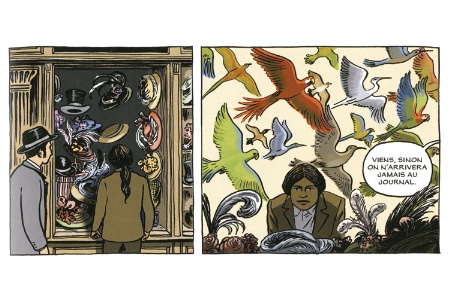
Once enrolled, Satrapi and her fellow female students are lectured on the need for longer headscarves. Ever recklessly outspoken, she gets up and points out that some of the men “wear clothes so tight that we can see everything. Why is it that I, as a woman, am expected to feel nothing when watching these men with their clothes sculpted on but they, as men, can get excited by two inches less of my headscarf?”
Summoned to the “Islamic Commission”, Satrapi is luckily received by the same sympathetic mullah, who decides not to expel her but to ask her to design a uniform that stays within the rules but is still “adapted to the needs of students in your college”. The result is a subtle compromise that, within the context of its time and place, represents a significant victory.
Coursework throws up similar challenges. Even in a gender-segregated art class, Satrapi is expected to draw a woman who is totally covered, so that “not a single part of her body was visible. We nonetheless learned to draw drapes.”
A male model, “on whom you could at least distinguish the limbs”, initially sounds more promising. But this leads to a visit from “the supervisors”, who demand to know whether she is looking at the man while drawing him, something that is “against the moral code”.
How girls and young women can get sidelined is also at the heart of Dotter of Her Father’s Eyes (2012), the award-winning graphic memoir/biography that Mary Talbot produced with her artist husband Bryan Talbot.
Growing up in the 1950s, she recalls, meant “big brothers, unheated bedrooms, chilblains, smog, overcooked vegetables, no television, hand-me-downs”. Her father, James Atherton, was a leading James Joyce scholar who mainly worked in schools but sometimes taught at places such as the Sorbonne and the State University of New York at Buffalo. Mary also became a distinguished academic, an expert on language, gender and consumer culture.
Dotter of Her Father’s Eyes shows us the human costs of academic and artistic obsession. It tells the tragic story of Joyce’s daughter, Lucia, who spent much of her life in mental institutions after her peripatetic family refused to take seriously her ambition to be a dancer. Yet this is interwoven with an account of Mary’s own childhood as the daughter of an irritable and patronising father who constantly screamed at her for interrupting his work – a long way from the idea of the academic as superhero.
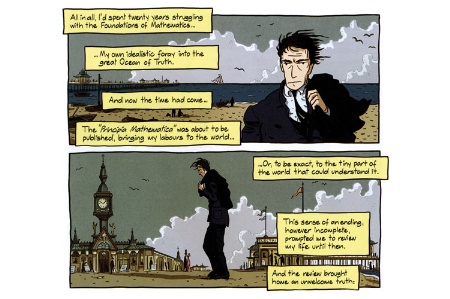
Logicomix reconstructs Bertrand Russell’s ‘epic search for truth’ while also incorporating episodes where the authors disagree about how to interpret the events
Another comic presents academic study in a rather different light. In 1910, Bertrand Russell and Alfred North Whitehead paid for the publication of the first volume of Principia Mathematica, a book designed to put the whole edifice of mathematics on firm foundations – and which famously took 362 pages to prove that “1 + 1 = 2”. It is hardly the most inviting of texts and, 30 years on, Russell claimed that he had met only a single person who had read it all the way through.
This might not sound very dramatic, yet Logicomix: An Epic Search for Truth (2009) argues that it forms the core of “a tragedy with logicians as heroes”, full of “fascinating people. Passionate…tortured. In fact, true superheroes.”
Russell, we learn, was brought up in Pembroke Lodge, now in the middle of south-west London’s Richmond Park, where the strange howls of a crazed uncle kept in the attic often terrified him. Fearful of succumbing to the madness that haunted his family, he treasured mathematics for granting him “the delicious experience of knowing something with total certainty” and was distraught to discover that one had to take certain axioms on trust.
Disappointed by the philosophers and mathematicians he meets in Cambridge, he embarks on his “epic search for truth” and sets off across Europe to meet his intellectual heroes. Almost all turn out to be quarrelsome, obsessive, absurdly literal-minded, wildly eccentric and, in at least one case, actually mad. Slowly Russell begins to realise that there is more to life than mathematics, as he finds love and emerges as a prominent peace campaigner.
Logicomix reconstructs all this in vivid and amusing detail, while also incorporating episodes where the authors, Apostolos Doxiadis and Christos H. Papadimitriou, disagree about how to interpret the events.
Papadimitriou cites evidence of a “curiously high rate of psychosis in the lives of the founders of logic”, so Doxiadis wonders whether their central characters “went mad from too much logic”. His partner is more tempted by the opposite view: perhaps “they became logicians from madness”, spurred on by their neurotic “passion and persistence” to seek “absolute certainty” even for such obvious truths as “1 + 1 = 2”.
Other questions crowd in as one reads about Russell, Whitehead, Ludwig Wittgenstein and the rival teams of squabbling French and German mathematicians. What are we to make of such strange people? Should they be admired, pitied or simply laughed at? The book provides no easy answers, but perhaps it does suggest something of what is genuinely heroic (and well as touchingly human) about the quests pursued by some academics, even if they have never been transformed into superheroes by unexpected blasts of gamma radiation.
Register to continue
Why register?
- Registration is free and only takes a moment
- Once registered, you can read 3 articles a month
- Sign up for our newsletter
Subscribe
Or subscribe for unlimited access to:
- Unlimited access to news, views, insights & reviews
- Digital editions
- Digital access to THE’s university and college rankings analysis
Already registered or a current subscriber? Login
